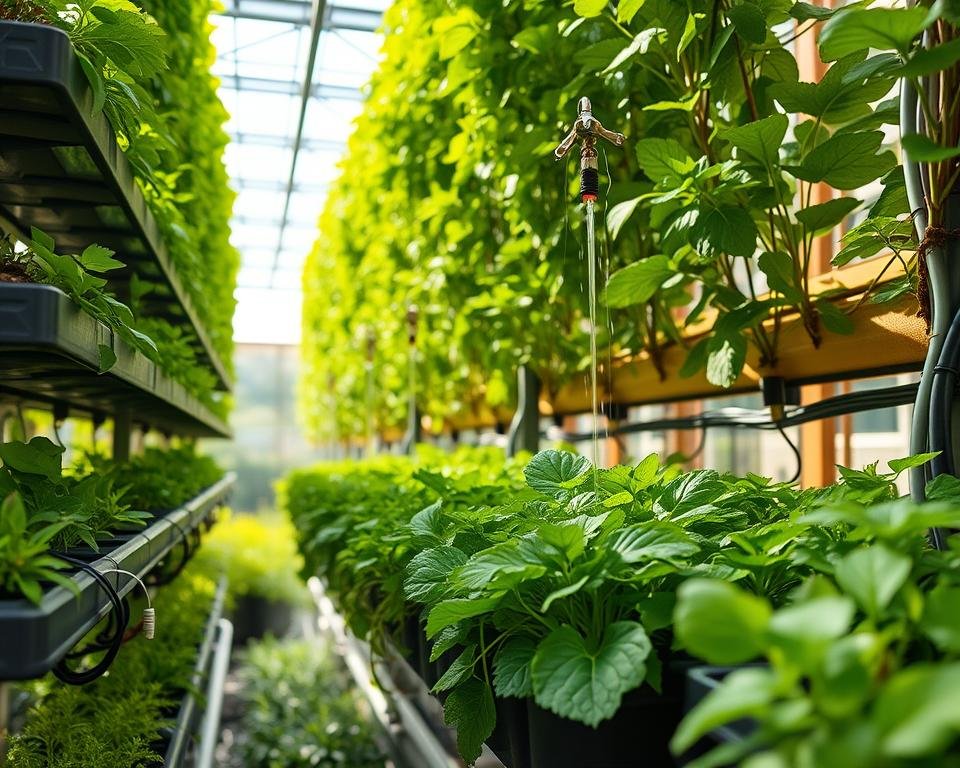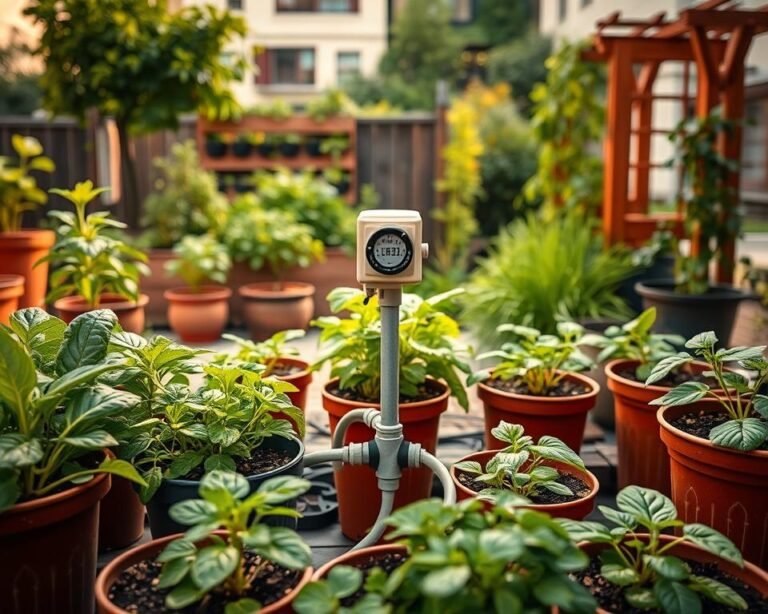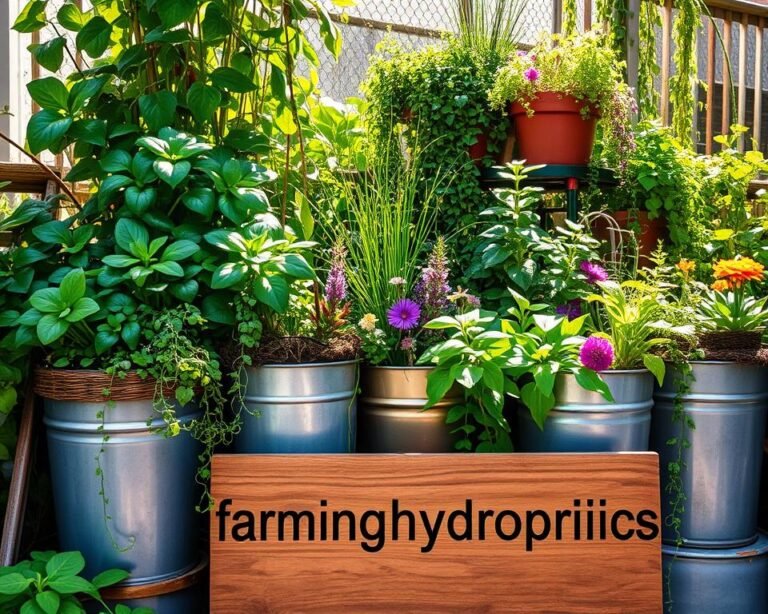Efficient Watering Techniques for Vertical Gardens
Imagine turning a blank wall into a lush, green oasis. This not only makes your space look better but also adds life to cities. Vertical gardens are perfect for those with little ground space, bringing greenery to new places. The secret to making these gardens thrive is in efficient watering.
Urban dwellers are finding creative ways to connect with nature. Vertical gardens are a beautiful answer. They work for city apartment dwellers and suburban homeowners alike. Knowing how to water your vertical garden can turn it into a lush, green wonder.
Watering vertical gardens needs to be precise. Unlike regular gardens, these spaces require special care to keep plants healthy. Whether it’s a small balcony garden or a big wall installation, the right watering techniques is crucial for success.
Key Takeaways
- Vertical gardens maximize limited space with innovative growing solutions
- Specialized irrigation is crucial for plant health and garden sustainability
- Water efficiency varies by season and plant type
- Proper watering prevents issues like over-watering and plant stress
- Technology can help optimize vertical garden irrigation
- Understanding local climate impacts watering strategies
- Maintenance is key to long-term vertical garden success
Understanding Vertical Garden Irrigation Systems
Vertical gardens need special irrigation to keep plants healthy and growing well. The right system can make your garden better and more sustainable. It’s key to manage water well for lush, green vertical gardens.
Irrigation systems for vertical gardens are mainly recirculating or non-recirculating. Each has its own benefits for keeping soil moist and watering plants.
Recirculating Systems
Recirculating systems are for big vertical gardens over 80 m². They collect and reuse water, saving a lot of water. The main benefits are:
- Up to 50% less water used
- Even moisture for plants
- Less harm to the environment
- Can save money on water bills
Non-recirculating Systems
For smaller gardens up to 50-80 m², non-recirculating systems are better. They might use more water, but they’re good for small spaces.
“Efficient irrigation is the cornerstone of successful vertical gardening.” – Urban Gardening Experts
System Components and Installation
Good irrigation for vertical gardens needs the right parts and careful setup. Here’s what you need:
| Component | Function | Performance Efficiency |
|---|---|---|
| Drip Emitters | Precise water delivery | 1-2 gallons per hour |
| Moisture Sensors | Water level monitoring | 90% moisture retention |
| Timers | Automated scheduling | 40% reduction in overwatering |
Using these advanced irrigation methods can make your vertical garden thrive. It will grow well and use less water.
Essential Watering Techniques for Vertical Gardens
Vertical gardening needs careful watering to keep plants healthy and save water. Different ways to water can greatly affect your garden’s success and how green it stays.
Drip Irrigation Methods
Drip systems are the best way to water vertical gardens. They send water straight to the roots, cutting down on waste and helping plants absorb it better. The main advantages are:
- Water savings up to 50% compared to traditional watering
- Reduced risk of plant disease
- Consistent moisture distribution
To use drip systems well, pick irrigation lines with at least 16 mm diameter. Also, choose in-line drippers that flow at least 1.6 liters per hour. This helps your vertical garden get the water it needs.
Sprinkler Systems and Application
Sprinkler systems work well for big vertical gardens with many plants. They are good for larger spaces. Here are some tips:
- Select adjustable sprinkler heads
- Use timers to control water distribution
- Position sprinklers to minimize water overlap
“The right sprinkler system can reduce water consumption while maintaining plant health.” – Urban Gardening Expert
Manual Watering Strategies
For small vertical gardens, watering by hand is a good choice. Collecting rainwater in gutters is a smart move. It can save up to 95% of rainwater for your garden.
Remember, each plant needs different amounts of water. Herbs might need less water than vegetables. So, watch how much each plant needs closely.
Calculating Water Requirements for Your Vertical Garden
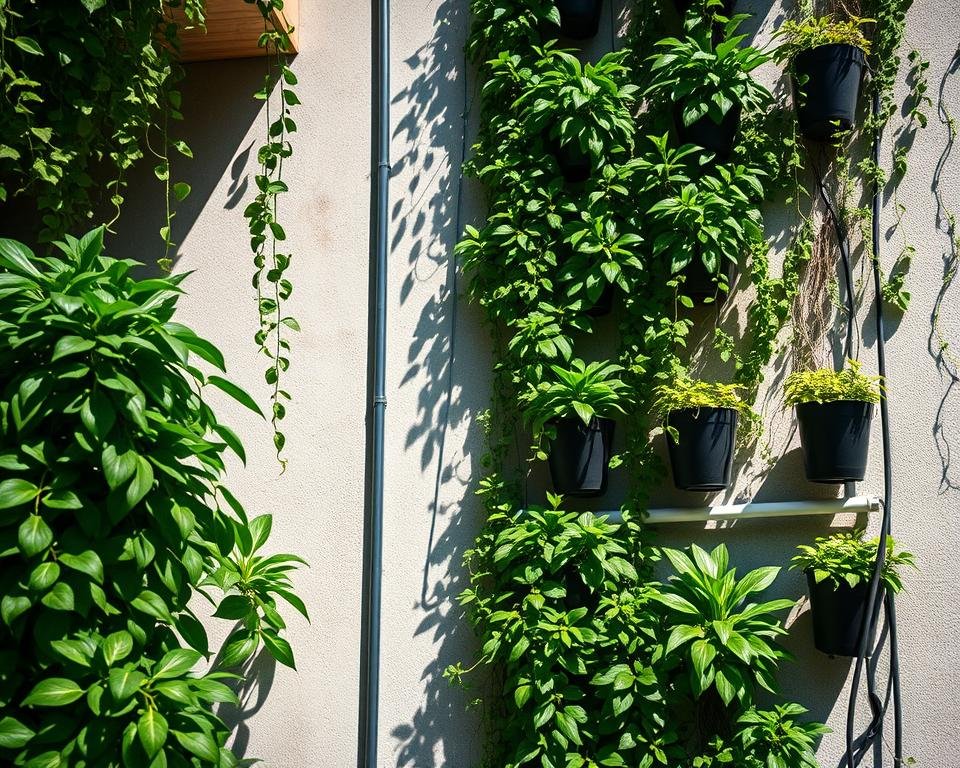
Knowing how much water your vertical garden needs is key. It depends on the plants, the weather, and how big your garden is. Saving water starts with measuring it right and planning well.
Each plant drinks water differently. Here’s a quick guide to their water needs:
- Lettuce: 1-2 liters per week
- Tomato plants: 5-8 liters during peak growth
- Drought-tolerant herbs: Minimal watering requirements
Managing soil moisture is also important for saving water. Evapotranspiration rates affect how much water your garden uses. In summer, plants might need up to 6 liters per square meter each day. But in winter, they need only about 1.5 liters.
“Precise water management is the key to a successful vertical garden.” – Urban Gardening Expert
To use water better, try these tips:
- Use moisture sensors to track soil hydration
- Implement drip irrigation systems
- Group plants with similar water requirements
- Monitor environmental conditions
Start with small systems if you’re new. This helps you learn about water use. With good planning and watching your garden, you can make a water-saving vertical garden that does well.
Automated Irrigation Solutions and Technologies
Modern vertical gardening is changing how we manage water. New technologies help gardeners control water better. This makes irrigation more precise and efficient.
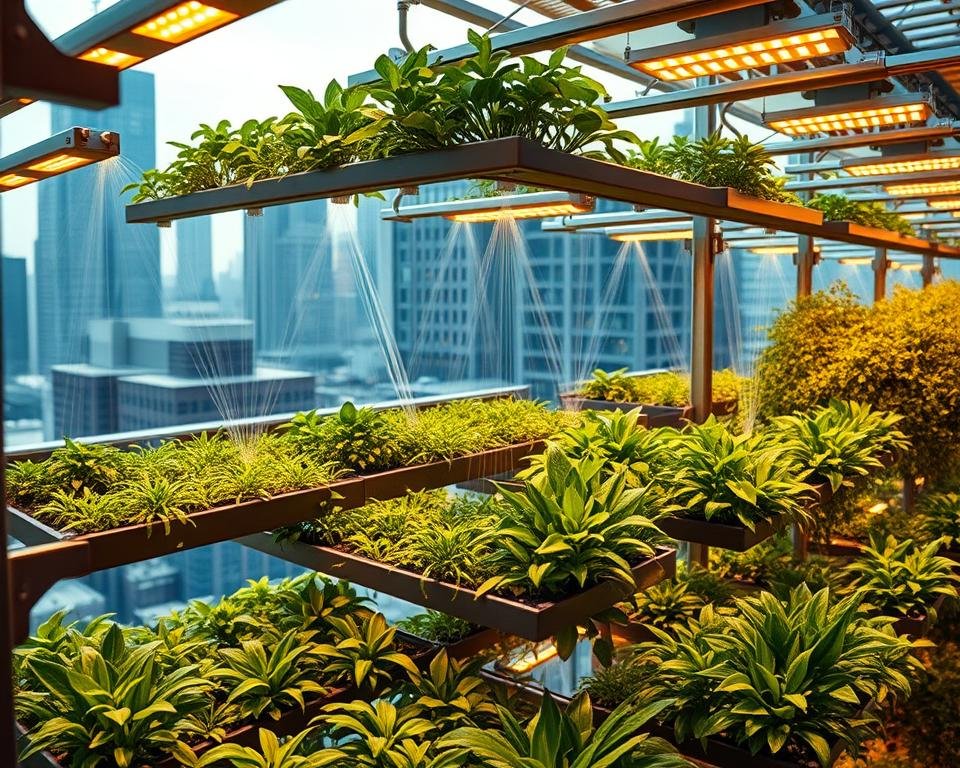
Automated irrigation solutions help gardeners save water and keep plants healthy. Studies show they can cut water use by up to 50% compared to old methods.
Smart Controllers and Timers
Water timers are key for efficient watering. These smart devices let you:
- Set watering schedules for each plant
- Change watering based on weather
- Avoid too much or too little water
Moisture Sensors and Monitoring Systems
Soil moisture management has improved with new sensors. These systems give important info on your garden’s water levels:
| Sensor Type | Key Benefits | Water Savings |
|---|---|---|
| Capacitive Sensors | Precise moisture measurement | Up to 40% reduction |
| Resistive Sensors | Real-time soil condition tracking | Up to 35% reduction |
Remote Control Applications
Modern irrigation tech gives gardeners more control. Mobile apps let you manage your garden’s watering from anywhere. You get:
- Real-time monitoring
- Quick schedule changes
- Full system checks
“Automation is not just about convenience—it’s about creating a smarter, more sustainable approach to gardening.” – Agricultural Technology Expert
Using these automated irrigation solutions can greatly improve your garden’s water use, plant health, and productivity.
Water Conservation Strategies and Sustainability
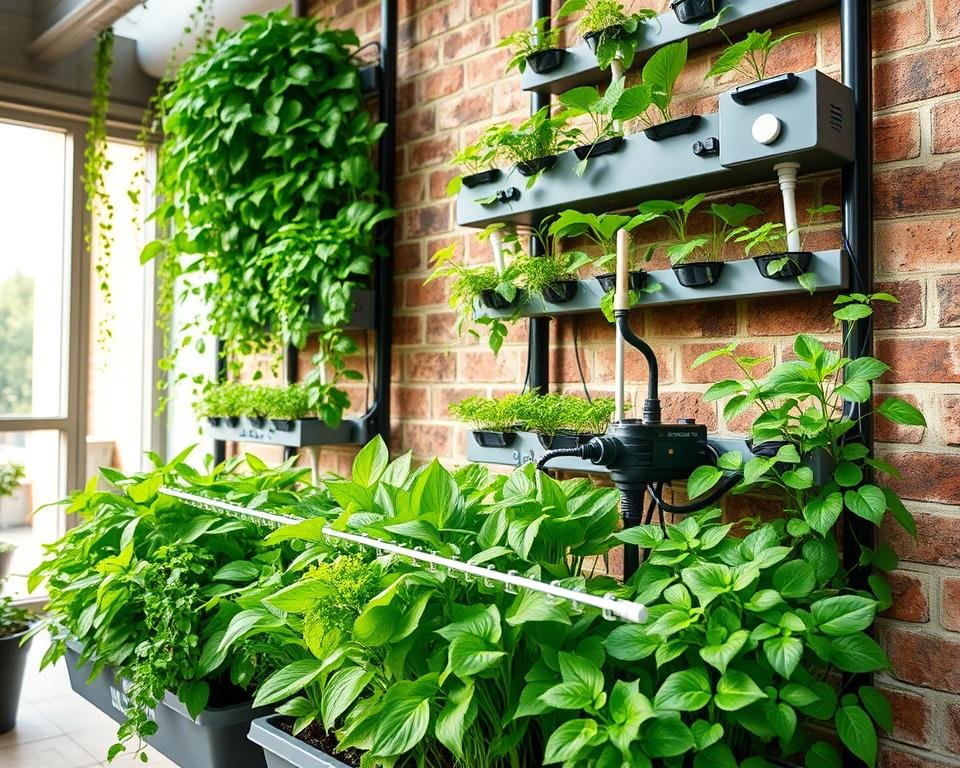
Vertical gardening is a great way to save water. It helps reduce water use, which is crucial since agriculture uses most of the world’s freshwater.
By using smart water-saving methods, your vertical garden can become a green oasis. Here are some important tips:
- Choose drought-tolerant plants that need less water
- Use drip irrigation to cut water use by half
- Collect and save rainfall utilization with rainwater harvesting
- Mulch to lower soil evaporation by up to 70%
“Water conservation is not about limiting growth, but about smart resource management.” – Environmental Expert
Smart irrigation can make your garden much more water-efficient. Soil moisture sensors can save 30-50% of water. Smart irrigation systems water plants just when they need it.
Make your vertical garden a symbol of water conservation. Pick native plants, use water-saving tech, and know your garden’s water needs. This way, you’ll have a lush space that’s kind to the planet.
Maintenance and Troubleshooting of Irrigation Systems
Keeping your vertical garden’s irrigation system in top shape is key to success. Regular upkeep ensures it works well, saves water, and keeps plants healthy. Knowing how to maintain it helps avoid expensive fixes and boosts its performance.
Good irrigation care includes several important steps to avoid common problems. Experts say doing thorough system checks can spot issues early.
Common Watering Issues
Irrigation systems face many challenges that can lower their efficiency:
- Clogged sprinkler heads (affecting 30% of systems)
- Uneven water distribution
- Low water pressure
- Electrical controller malfunctions
System Cleaning and Upkeep
To keep your irrigation system running smoothly, follow these steps:
- Regularly check the water tank
- Clean filters every month
- Test water conductivity
- Check pH levels
Regular maintenance can cut down irrigation system problems by up to 50%.
Seasonal Adjustments
| Season | Maintenance Action | Water Savings |
|---|---|---|
| Spring | Reset watering schedules | 15-20% |
| Summer | Adjust for increased heat | 10-15% |
| Fall | Reduce watering frequency | 20-25% |
| Winter | Minimal irrigation | 30-40% |
By following these maintenance tips, you’ll improve your vertical garden’s irrigation efficiency. This ensures your plants get the right amount of water all year round.
Conclusion
Creating a good irrigation plan for your vertical garden is key for plants to grow well. By using the tips from this guide, you can make your vertical garden water-friendly and full of life. It’s all about finding the right way to water that keeps plants healthy and uses less water.
Water saving is very important in vertical garden design. Drip irrigation systems are super efficient, cutting down water waste by giving plants just what they need. They can save up to 50% more water than old ways of watering, making them great for those who care about the planet and want a healthy garden.
Building a successful vertical garden means picking the best watering methods for your plants and the environment. Using smart tools like moisture sensors and automated systems can help you water perfectly. Remember, each plant is different, so tailoring your watering plan will help your plants grow strong and use less water.
With the knowledge from this guide, you can make a vertical garden that uses less water but still looks great. Start using these watering tips to turn your garden into a water-saving success story. It shows that you can have a beautiful garden without wasting water.

